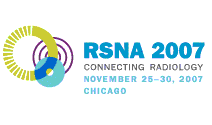
Abstract Archives of the RSNA, 2007
SST04-07
Hyperechoic Ovarian Stroma: Not an Ultrasonographic Sign of Polycystic Ovarian Syndrome (PCOS)
Scientific Papers
Presented on November 30, 2007
Presented as part of SST04: Genitourinary (Ultrasound)
Hsu-Chong Yeh MD, Presenter: Nothing to Disclose
Walter Futterweit MD, Abstract Co-Author: Nothing to Disclose
Hyperechoic ovarian stroma has been regarded as one of the most important signs of PCOS. This paper will evaluate the echogenicity of ovarian stroma in patients with and without PCOS.
One hundred twenty two (122) ovaries in 61 patients with PCOS and 124 ovaries in 83 patients of reproductive age without PCOS were examined with endovaginal ultrasonography to evaluate the echogenicity of ovarian stroma. The echogenicity of ovarian stroma was compared to that of myometrium. Only appropriate areas of the ovarian stroma were selected for this study, in particular, the areas that are posterior to follicles, cysts or large pelvic veins or within reverberation echoes etc.were avoided.
In all patients with or without PCOS, the echogenicity of ovarian stroma are either isoechoic or slightly, moderately, or markedly hypoechoic to myometrium, with incidences of 32.8%, 36.1%, 27% and 4.1% respectively for PCOS patients; 21.8%, 41.9%, 30.7% and 5.6% respectively for non-PCOS patients. Wilcoxon Rank Sum test: p = 0.105 which indicates no significant difference between the two groups of patients. No ovary has stroma truly hyperechoic to myometrium.
The true echogenicity of the ovarian stroma in patients with or without PCOS is either iso- or hypoechoic to the myometrium. Hyperechoic ovarian stroma is not a feature for PCOS. The “apparent” hyperechogenicity was seen in the areas that are posterior to follicles or cysts due to good through transmission or due to some other artifacts and not truly hyperechoic.
Hyperechoic ovarian stroma should not be considered as a sign for diagnosing PCOS.
Yeh, H,
Futterweit, W,
Hyperechoic Ovarian Stroma: Not an Ultrasonographic Sign of Polycystic Ovarian Syndrome (PCOS). Radiological Society of North America 2007 Scientific Assembly and Annual Meeting, November 25 - November 30, 2007 ,Chicago IL.
http://archive.rsna.org/2007/5011438.html

